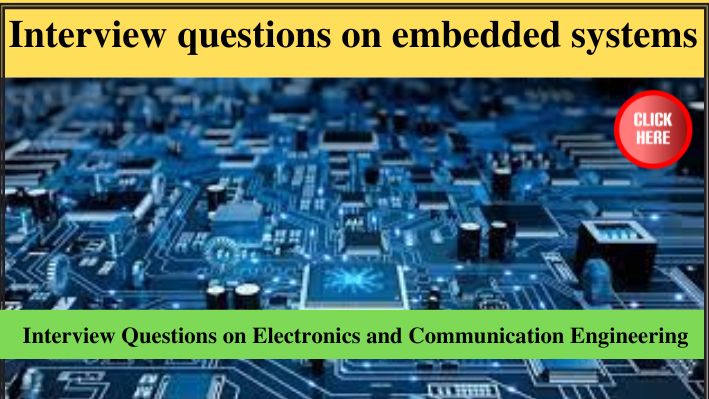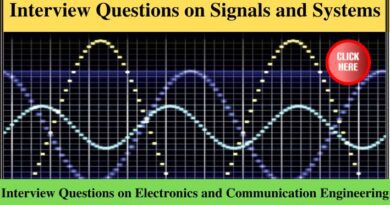Interview questions on embedded systems
Hello, In this blog, we will discuss Interview questions on embedded systems, These questions are asked in many interviews repeatedly, Please read the interview questions. Feel free to ask doubts or suggestions on it
Interview questions on satellite communication
Interview questions on embedded systems
What is an Embedded System?
An Embedded System is a computer system that is integrated into a larger device to perform specific tasks. It combines hardware and software components to perform specific functions and can interact with the external environment through sensors and actuators.
What is the difference between an Embedded System and a General-Purpose Computer System?
An Embedded System is designed to perform specific tasks, whereas a general-purpose computer system is designed to perform a wide range of tasks. An Embedded System typically has limited processing power and memory compared to a general-purpose computer, but it is designed to be more efficient, smaller, and cheaper.
What are the main components of an Embedded System?
The main components of an Embedded System are: a microcontroller, memory, input/output interfaces, and power supply.
What is a Microcontroller and what does it do?
A Microcontroller is a small computer on a single integrated circuit that contains a processor, memory, and peripheral interfaces. It is the central processing unit (CPU) of an Embedded System and is responsible for executing instructions and controlling the overall operation of the system.
What is a real-time operating system (RTOS)?
A Real-time Operating System (RTOS) is an operating system designed to meet the requirements of real-time applications, such as response time and predictability. An RTOS provides a predictable and deterministic response to events, ensuring that important tasks are executed within a specified time.
What is the purpose of Embedded Firmware?
Embedded Firmware is software that is pre-installed on an embedded system and controls the hardware. It provides low-level control over the system’s hardware and is responsible for initializing the hardware, handling input/output, and performing other tasks specific to the system.
Some more Interview questions on embedded systems (Part-1)
Can you explain the role of Interrupts in an Embedded System?
Interrupts are used to temporarily halt the execution of the main program to process a high-priority task. When an interrupt event occurs, the microcontroller stops the execution of the current task, saves the current state, and jumps to a special interrupt service routine (ISR) to handle the event. Once the ISR is completed, the microcontroller restores the saved state and resumes execution of the main program.
What is the difference between Polling and Interrupts?
In Polling, the main program continuously checks the status of inputs to determine if an event has occurred. In Interrupts, the microcontroller stops the execution of the main program and jumps to the ISR only when an event has occurred. Interrupts are more efficient than polling because they save processing time and allow the microcontroller to perform other tasks while waiting for an event to occur.
Can you discuss some of the most common programming languages used in Embedded Systems?
C and C++ are the most common programming languages used in Embedded Systems. Assembly language is also used in some cases, particularly for low-level control over the system’s hardware.
Can you discuss some of the challenges in Embedded Systems development?
Some of the challenges in Embedded Systems development include limited processing power and memory, real-time constraints, hardware/software integration, and reliability and safety concerns. It is also challenging to debug and test embedded systems, especially when the system is integrated into a larger device.
What is memory mapping in Embedded Systems?
Memory mapping is the process of mapping the address space of a microcontroller to specific memory locations. This allows the microcontroller to access and manipulate the memory as required by the system’s firmware.
Part-2:
Can you explain the difference between volatile and non-volatile memory in Embedded Systems?
Volatile memory is a temporary memory that loses its data when power is turned off. Examples of volatile memory include RAM (Random Access Memory) and cache memory. Non-volatile memory, on the other hand, retains its data even when power is turned off. Examples of non-volatile memory include ROM (Read-Only Memory), flash memory, and EEPROM (Electrically Erasable Programmable Read-Only Memory).
What is the difference between Little Endian and Big Endian in Embedded Systems?
Little Endian and Big Endian are two ways of storing multibyte data in memory. In Little Endian, the least significant byte is stored first, while in Big Endian, the most significant byte is stored first. The choice of Endian depends on the system’s architecture and the needs of the firmware.
Can you explain the concept of Watchdog Timers in Embedded Systems?
A Watchdog Timer is a hardware timer that is used to reset the system if it stops responding. The firmware periodically resets the watchdog timer, and if the timer expires, the system is reset to recover from a fault.
Can you discuss the role of Power Management in Embedded Systems?
Power Management is an important aspect of Embedded Systems as it affects the system’s performance, battery life, and reliability. The firmware must manage the power consumption of the system by turning off unused peripherals, reducing the clock speed of the processor, and implementing power-saving modes.
Part-3:
Can you explain the difference between Hard Real-Time and Soft Real-Time systems?
Hard Real-Time systems are systems where the response time is critical and a missed deadline can have serious consequences. Examples of Hard Real-Time systems include control systems for medical equipment and safety-critical systems in aerospace and defense. Soft Real-Time systems, on the other hand, have less stringent timing requirements and a missed deadline may have less severe consequences. Examples of Soft Real-Time systems include multimedia systems and gaming systems.
Can you discuss the role of Embedded Systems in IoT (Internet of Things)?
Embedded Systems play a crucial role in IoT by providing intelligence and control for IoT devices. IoT devices typically have limited processing power and memory, so the firmware must be optimized for efficiency and cost. The firmware must also handle communication with other IoT devices and the cloud to provide seamless integration and data exchange.
Interview questions on microwave engineering
Conclusion:
I hope this blog: Interview questions on embedded systems Helpful to you, For more interesting interview questions visit our website Digital Tech Fact



